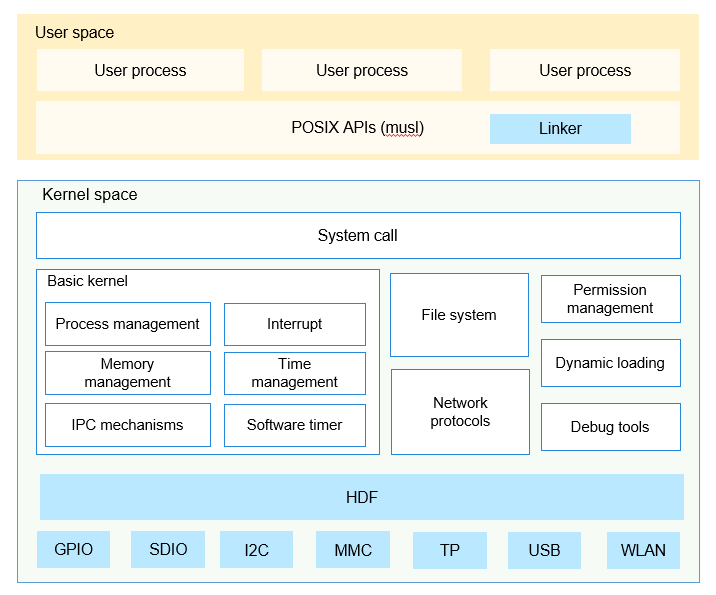Kernel Overview
Overview
The OpenHarmony lightweight kernel is a next-generation kernel that evolved from the kernel of Huawei LiteOS, a lightweight IoT operating system. The kernel comes with two patterns: LiteOS-M and LiteOS-A. The LiteOS-M kernel is designed for the mini system, which supports KB-level MCU memory and MPU isolation. Typical counterparts in the industry include FreeRTOS and ThreadX. The LiteOS-A kernel is ideal for the small system, which supports MB-level memory and MMU isolation. Equivalent kernels include Zircon and Darwin.
NOTE: OpenHarmony provides different kernels for different systems. The small system supports LiteOS and Linux. This document applies to the LiteOS-A kernel. For details about operations related to the Linux kernel, see Linux Kernel Overview.
To keep pace with the rapid development of the IoT industry, the OpenHarmony lightweight kernel is continuously optimized and expanded to provide application developers with friendly development experience and unified and open ecosystem capabilities. The LiteOS-A has the following new features:
-
Diversified kernel mechanisms
Mechanisms such as virtual memory, system calling, multi-core, lightweight Inter-Process Communication (IPC), and Discretionary Access Control (DAC) are added to enrich kernel capabilities. To improve compatibility with software and developer experience, multiple processes are supported to isolate memory between applications and improve system robustness.
-
Unified hardware driver foundation (HDF)
The HDF provides unified driver standards and access mode for device vendors. This simplifies porting of drivers and allows one-time development for multi-device deployment.
-
1200+ standard POSIX APIs
The kernel supports more Portable Operating System Interface (POSIX) APIs, which facilitate software development and porting and improve developers' experience.
-
Decoupling between the kernel and hardware
The lightweight kernel is highly decoupled from the hardware. New board can be added without modifying the kernel code.
Kernel Architecture
The lightweight kernel consists of the basic kernel, extended components, HDF, and POSIX APIs. Different from the microkernel which is running in the user mode, the extended functions, such as the file system and network protocols, of the lightweight kernel are running in the kernel address space. The direct function calling between components is much faster than inter-process communication (IPC) or remote procedure calls (RPCs).
Figure 1 Architecture of the OpenHarmony LiteOS-A kernel

- The basic kernel implements basic kernel mechanisms, such as scheduling, memory management, and interrupts.
- Extended components include file systems, network protocols, permission management, and more.
- The HDF provides a unified standard framework for peripheral drivers.
- The POSIX APIs allow POSIX-compliant applications to be easily ported to the OpenHarmony.
Basic Kernel
The basic kernel implements the following mechanisms:
- Process management: manages processes and threads and supports task-based process implementation. Processes have independent 4 GiB address space.
- Multi-core scheduling: supports CPU affinity settings, allowing the binding and unbinding of a task or interrupt to one or more CPU cores.
- Real-time scheduling: schedules tasks based on priorities. The tasks of the same priority are scheduled by using the time slice polling.
- Virtual memory: supports static mapping of the kernel space to 0-1 GiB addresses, and mapping of the user space to 1-4 GiB addresses.
- Kernel communication: supports events, semaphores, mutexes, and queues.
- Time management: supports software timers and the system clock.
File systems
The LiteOS-A supports multiple file systems, such as FAT, JFFS2, NFS, ramfs, and procfs, and provides complete standard POSIX APIs. The VFS layer is used as the unified adaptation layer framework, which facilitates the porting of new file systems. Each file system can automatically use the rich functions provided by the VFS layer.
The following features are supported:
- Complete POSIX API support
- File-level cache (PageCache)
- Disk-level cache (Bcache)
- Directory cache (path cache)
- DAC capability
- Nested mounting and file system stacking
- Feature tailoring and flexible configuration of resource usage
Network Protocols
The LiteOS-A network protocols are constructed based on the open-source lightweight IP (lwIP), optimizing the RAM usage while improving the transmission performance over lwIP.
- Protocols: IP, IPv6, ICMP, ND, MLD, UDP, TCP, IGMP, ARP, PPPoS, and PPPoE
- API: socket API
- Extended features: IP forwarding based on multiple network ports, TCP congestion control, round-trip time (RTT) estimation, and fast recovery/retransmission
- Application programs: HTTP(S) service, SNTP client, SMTP(S) client, ping tool, NetBIOS name service, mDNS response program, MQTT client, TFTP service, DHCP client, DNS client, AutoIP/APIPA (zero configuration), and SNMP agent
HDF
The LiteOS-A integrates the HDF framework. The HDF framework provides a more precise and efficient development environment, aiming to realize one-time development for multi-device deployment. The HDF supports:
- Multi-kernel platform
- User-mode drivers
- Configurable component-based driver model
- Message-based driver interface model
- Object-based driver and device management
- Unified hardware device interface (HDI)
- Power management and plug and play (PnP)
Extended Components
Extended components provide optional but important mechanism for extending kernel functions.
- Dynamic linking: supports standard Executable and Linkable Format (ELF) execution and randomization of loading addresses.
- IPC: supports LiteIPC and standard mechanisms such as Mqueue, Pipe, FIFO, and Signal.
- System calling: supports 170+ system calls and the virtual dynamic shared object (vDSO) mechanism.
- Permission management: supports process-based privilege division and control, and file user, group, and other (UGO) permission configuration.